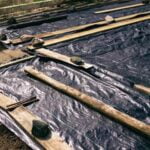Pressure treated lumber is a popular choice for outdoor projects, but is Home Depot pressure treated lumber safe for vegetable gardens? When it comes to growing our own food, it’s crucial to prioritize the safety of the materials we use. In this article, we will explore the potential risks of using pressure treated lumber in vegetable gardens and discuss alternative options for building raised beds and garden structures.
As more people turn to gardening as a way to secure their food source, the importance of using safe materials in vegetable gardens cannot be overstated. Pressure treated lumber is commonly used in outdoor construction due to its resistance to rot and insects. However, concerns have been raised about the chemicals used in the treatment process and their potential impact on soil and plants.
In this comprehensive guide, we will delve into what pressure treated lumber is and why it is used in outdoor projects. We will also examine the different types of pressure treated lumber available at Home Depot and their safety levels for vegetable gardens.
Additionally, we will provide tips on how to properly use and handle pressure treated lumber in a vegetable garden setting to minimize risks. Let’s explore the best options for ensuring that our beloved vegetable gardens remain safe and healthy environments for growing nutritious produce.
What Is Pressure Treated Lumber and Why Is It Used in Outdoor Projects?
Pressure treated lumber is a type of wood that has been treated with chemicals to increase its durability and resistance to decay, mold, and insects. This treatment involves soaking the wood in a preservative solution under high pressure, causing the chemicals to penetrate deep into the fibers of the wood. The most common chemicals used in this process are chromated copper arsenate (CCA), alkaline copper quaternary (ACQ), and copper azole (CA-B).
One of the primary reasons why pressure treated lumber is popular for outdoor projects, including building raised beds and garden structures, is its ability to withstand harsh environmental conditions. The treatment process significantly extends the lifespan of the wood, making it ideal for use in areas where it will be exposed to moisture, soil, and frequent contact with plants.
Benefits of Using Pressure Treated Lumber
The use of pressure treated lumber offers several benefits for outdoor construction. Firstly, it is more resistant to rotting, decay, and insect damage compared to untreated wood. This makes it an excellent choice for long-term projects such as garden beds and fences. Additionally, pressure treated lumber requires minimal maintenance over time, saving gardeners both time and money on repairs or replacements.
Common Uses for Pressure Treated Lumber in Outdoor Projects
In addition to being favored for building vegetable garden structures like raised beds, pressure treated lumber is commonly used in construction applications such as decks, patios, walkways, and retaining walls. Its versatility and durability make it a popular choice for a wide range of outdoor needs. Understanding these uses can help gardeners make informed decisions about whether or not pressure treated lumber is suitable for their specific vegetable garden setup.
The Potential Risks of Using Pressure Treated Lumber in Vegetable Gardens
Pressure treated lumber is a popular choice for outdoor construction projects due to its resistance to rot, decay, and termite infestation. However, using pressure treated lumber in vegetable gardens has raised concerns about the potential risks it may pose to the health of plants and individuals consuming the produce. Understanding these risks is crucial for making informed decisions when selecting materials for garden structures and raised beds.
Chemical Concerns
The primary concern with pressure treated lumber in vegetable gardens is the presence of chemicals such as arsenic, chromated copper arsenate (CCA), and other preservatives used to extend its lifespan. These chemicals can leach into the soil over time, potentially contaminating the vegetables grown in close proximity.
Health Risks
Exposure to these chemicals can also pose health risks to gardeners and their families. Contact with the skin or inhalation of sawdust from pressure treated lumber can lead to irritation or more serious health issues over time. Ingesting vegetables grown in soil contaminated by these chemicals could also have adverse effects on human health.
Environmental Impact
In addition to concerns about human health, there are also environmental considerations when using pressure treated lumber in vegetable gardens. The leaching of chemicals into the surrounding soil can have a detrimental impact on local ecosystems and water sources, affecting not only the immediate garden area but potentially larger areas downstream.
It is essential for gardeners to weigh these potential risks before deciding whether or not to use Home Depot pressure treated lumber in their vegetable gardens.
The Different Types of Pressure Treated Lumber and Their Safety Levels for Vegetable Gardens
Pressure treated lumber is a popular choice for outdoor projects due to its resistance to rot, decay, and insect damage. However, when it comes to using pressure treated lumber in vegetable gardens, the safety of the material becomes a significant concern. There are different types of pressure treated lumber available at Home Depot, each with varying levels of safety for use in vegetable gardens.
1. ACQ Treated Lumber: This type of pressure treated lumber contains alkaline copper quaternary and is considered safe for use in vegetable gardens. It does not contain any arsenic or chromium.
2. Copper Azole Treated Lumber: Another safe option for vegetable gardens, this type of pressure treated lumber uses copper and an organic azole compound as preservatives.
3. Chromated Copper Arsenate (CCA) Treated Lumber: CCA-treated lumber is not recommended for use in vegetable gardens due to its arsenic content, which can potentially leach into the soil and be absorbed by plants.
It is important to carefully consider the type of pressure treated lumber being used in a vegetable garden setting. While some types are deemed safe for use, others pose potential risks to the health of both humans and plants.
When considering using Home Depot pressure treated lumber in a vegetable garden, it is crucial to opt for safer alternatives or choose only the types that are specifically labeled as safe for such applications. Making an informed decision about the safety levels of different types of pressure treated lumber will help ensure the well-being of both your garden and yourself.
Alternatives to Pressure Treated Lumber for Building Raised Beds and Garden Structures
When looking for alternatives to pressure treated lumber for building raised beds and garden structures in your vegetable garden, it is important to consider materials that are not treated with chemicals that could potentially harm your plants or contaminate your produce. Below are some safe and viable alternatives to pressure treated lumber:
1. Cedar: Cedar is a popular choice for building raised beds due to its natural resistance to rot and insects. It is also free from harmful chemicals, making it a safe option for vegetable gardens.
2. Redwood: Similar to cedar, redwood is naturally resistant to decay and pests. It is a durable and attractive option for constructing raised beds and garden structures without the use of chemical treatments.
3. Composite lumber: Made from a combination of wood fibers and recycled plastic, composite lumber is a low-maintenance alternative to traditional wood that does not require chemical treatment. It is available in various colors and styles, providing both durability and aesthetic appeal for your vegetable garden projects.
4. Untreated hardwood: Hardwoods such as oak or black locust can also be used for building raised beds, as they have natural resistance to decay and do not require chemical treatment.
Using any of these alternatives can help ensure the safety of your vegetable garden while still providing sturdy and long-lasting structures for your plants. Before making a decision on which material to use, consider factors such as cost, availability, durability, and the specific needs of your garden project.
How to Properly Use Pressure Treated Lumber in Vegetable Gardens to Minimize Risks
Pressure treated lumber can release harmful chemicals into the soil and pose a risk to the health of your vegetable garden. However, if you choose to use Home Depot pressure treated lumber for building raised beds or garden structures, there are several ways to minimize the potential risks and ensure the safety of your crops.
One important step in properly using pressure treated lumber in vegetable gardens is to create a barrier between the wood and the soil. This can be achieved by lining the inside of the bed with heavy-duty plastic sheeting, landscape fabric, or some other impermeable material. By doing so, you can prevent direct contact between the soil and the pressure treated lumber, reducing the risk of chemical leaching into your garden.
In addition to creating a barrier, it is also essential to avoid using pressure treated lumber for any part of your vegetable garden where it may come into direct contact with edible parts of your crops. Instead, use untreated lumber or natural materials such as cedar or redwood for constructing planting surfaces and borders where they are in direct contact with soil or plants.
This will help prevent any potential transfer of chemicals from the pressure treated wood to your vegetables.
Finally, it’s crucial to follow proper maintenance and care practices when using pressure treated lumber in vegetable gardens. Regularly inspect the wood for signs of deterioration or damage, as this can increase leaching of chemicals into the surrounding environment. Additionally, avoid burning pressure treated lumber scraps or sawdust as this can release toxic fumes into the air.
| Proper Use | Risks Minimized |
|---|---|
| Create a barrier between wood and soil | Prevent chemical leaching into garden |
| Avoid direct contact with edible parts of crops | Prevent transfer of chemicals to vegetables |
| Regularly inspect for damage and avoid burning |
Tips for Safe Handling and Disposal of Pressure Treated Lumber in a Vegetable Garden Setting
Pressure treated lumber is a popular choice for outdoor projects due to its resistance to rot, decay, and insect damage. However, when it comes to using pressure treated lumber in a vegetable garden setting, there are important considerations to keep in mind for safe handling and disposal.
When working with pressure treated lumber in a vegetable garden, it is crucial to wear protective gear such as gloves and a dust mask to minimize direct contact with the chemicals used in the treatment process. This also applies when handling sawdust or scraps from the wood, as they can release harmful chemicals into the air.
Additionally, proper disposal of pressure treated lumber is essential to prevent potential contamination of the soil and surrounding environment. The Environmental Protection Agency (EPA) recommends disposing of pressure treated lumber by taking it to a designated landfill that accepts this type of waste. Burning pressure treated lumber should be avoided as it releases toxic chemicals into the air.
It is important for gardeners and DIY enthusiasts alike to be aware of these safety measures when working with pressure treated lumber in vegetable gardens. By taking these precautions, the potential risks associated with using this type of wood can be minimized, allowing for a safer gardening experience.
| Tips for Safe Handling and Disposal | Pressure Treated Lumber |
|---|---|
| Wear protective gear such as gloves and a dust mask | Minimize direct contact with chemicals |
| Proper disposal at designated landfills | Avoid burning pressure treated lumber |
Conclusion
In conclusion, the decision to use Home Depot pressure treated lumber in vegetable gardens should be approached with caution and careful consideration of the potential risks involved. While pressure treated lumber offers durability and resistance to decay, it also poses a risk of chemical leaching into the soil, potentially contaminating edible plants. It is important for gardeners to weigh the benefits and drawbacks of using this type of lumber in their projects.
It is crucial for gardeners to carefully research and understand the types of pressure treated lumber available at Home Depot, as well as their safety levels for vegetable gardens. Knowing the specific chemicals used in the treatment process can help in making an informed decision about whether or not to use pressure treated lumber in a vegetable garden setting.
Additionally, exploring alternative materials for building raised beds and garden structures, such as cedar or composite lumber, can provide a safer option for growing vegetables.
Ultimately, it is essential to prioritize the health and safety of both the plants and those consuming them when deciding whether to use Home Depot pressure treated lumber in a vegetable garden. By taking proper precautions, such as sealing the wood and minimizing direct contact between the lumber and soil, gardeners can minimize the risks associated with using pressure treated lumber while still achieving their outdoor project goals.
Frequently Asked Questions
Is It OK to Use Pressure Treated Wood in a Vegetable Garden?
Using pressure treated wood in a vegetable garden is a controversial topic. While some experts say that it’s okay because the chemicals are now considered safe, others still have concerns about potential leaching of harmful substances into the soil.
Is Home Depot Pressure Treated Wood Safe for Vegetable Gardens?
Home Depot pressure treated wood is generally deemed safe for vegetable gardens, as the chemicals used in the treatment process are said to be less toxic than they once were. However, it’s always best to do thorough research and consider personal comfort levels before use.
Is Lowe’s Pressure Treated Wood Safe for Vegetable Gardens?
Lowe’s pressure treated wood is also considered safe for vegetable gardens by some, as they too claim to use less toxic chemicals in their treatment process. However, just like with any pressure treated wood, it’s important to weigh the potential risks and benefits before using it in a vegetable garden.

If you’re looking to get into vegetable gardening, or are just looking for some tips on how to make your current garden better, then you’ve come to the right place! My name is Ethel and I have been gardening for years. In this blog, I’m going to share with you some of my best tips on how to create a successful vegetable garden.





